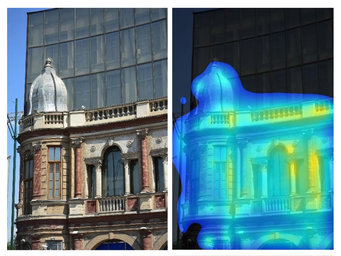What people find beautiful is highly individual. Aenne Brielmann and her team at the Max Planck Institute of Biological Cybernetics want to know how the perception of beauty comes about and what effect environmental design has on our well-being.

Left: a building from the 1920s in Tehran, in front of a glass façade. Right: The false colour representation shows how strongly a person perceives the buildings. Yellow elements indicate what attracts the human eye the most; elements attracting the least visual attention are blue and black. The glass façade in the background is practically invisible to the human mind.
© Lavdas, A.A.; Salingaros, N.A.; Sussman, A., CC-BY 4.0
of a glass façade. Right: The false colour representation shows how strongly a person perceives the buildings. Yellow elements indicate what attracts the human eye the most; elements attracting the least visual attention are blue and black. The glass façade in the background is practically invisible to the human mind.
Text: Aenne Brielmann
What we wear, where we like to spend time, what we do in our free time: every day, we make decisions based on a preference for a certain sight, sound or taste. This aspect of personal predilection has long been used in advertising, and yet science has largely ignored it. This might be because it is difficult to measure "liking". Another possible reason is the wide range of personal tastes. Our research group at the Max Planck Institute for Biological Cybernetics in Tübingen wants to explore the essence of beauty and analyse it using scientific methods. To do so, we are also working together with philosophers, computer scientists, and architects.
One and the same external stimulus can cause different reactions in the brain. A sound, for example, may be pleasing to one person but disagreeable to another. My team and I want to find out how sensory input is transformed into an output such as liking or disliking. This will allow us to develop a model and make predictions about how a stimulus is processed despite individual differences. We set up a theory for this process in the form of a mathematical model. One day, we would like to use this to predict which things our brain particularly likes and which changes in our living environment can increase health and well-being.
Our theory assumes that the feeling of liking something means that a sensory experience is good for our sensory system. In this context, 'good' means that the experience can be processed well by our brain and that it also helps the brain learn to process other encounters in the future. So, when we choose an option that is more pleasant for us, we opt for a sensory experience that is easier to process and from which we can learn something. Their rewarding nature makes us want to have such experiences again and again.
Beauty is not only a question of taste
Let's take Barcelona as an example: Every year millions of people visit the city and stroll through "Las Ramblas", supposedly the most beautiful street in the world. What makes this street so special? Why do so many people find this place beautiful? In the world of architecture and design, it is usually assumed that beauty is in the eye of the beholder. However, scientists now know that some aesthetic preferences have a biological basis. In order to record and measure the perception of visual beauty, we deliberately do not use questionnaires. Above all, they would reflect what people perceive as pleasant and beautiful due to their conditioning, because, for example, their understanding of art or their acclimatisation to today's cities would influence the answers. Instead, we use the technique of eye-tracking. We use cameras to record the viewer's field of vision and their eye movements. Computer programs then calculate where the viewers were looking. Recording the direction of a gaze is a wonderful tool for capturing unconscious attention. It also gives an indication of preferences and likes. Even small children look at pleasant objects unconsciously and actually direct their bodies towards them.
People like things that resemble nature
Which objects or environments can our brain process well and which can it learn from? More specifically: what factors should we consider when building and designing cities to ensure that they are not only functional but also "beautiful"? Nature comes to mind right away here; in fact, many studies have confirmed that people like things which resemble nature. This doesn't just mean that embracing natural elements like sunlight, water, and plants makes us feel better about our surroundings. Abstract characteristics can also be copied from nature.

It is no coincidence that Moraine Lake is one of the most photographed motifs in Canada. The reflecting lake surface, the rugged mountain peaks and the lush green forest offer the eye a wealth of sensory stimuli.
© James Wheeler / Pixabay
The best known of these characteristics is fractality, a principle according to which the whole resembles its constituent parts. Fractal structures are not only found in biology, but also in music and mathematics. A tree is a good example of a fractal pattern: the structure of a branch resembles that of the whole tree, the partial branches in turn resemble the main branch. This pattern is repeated in perpetually smaller forms, up to the branching of the leaf veins. In other words, a tree is visually stimulating. Eye-tracking experiments show that people also have a preference for fractals in architecture. The more a façade corresponds to fractal patterns, the more likely the eyes are to linger on it. In fact, most traditional architectural styles include such fractal elements. An empty concrete or glass façade, by contrast, has nothing to offer our eyes.
New sensations stimulate the senses
So why do tourists find "Las Ramblas" so beautiful? Because the street always presents the walker with new sensory stimuli. Its architecture is simple to process but at the same time complex enough to provide further learning experiences - just like games motivate us most when they are not too hard and not too easy. The successive stream of stimulation that "Las Ramblas" offers encourages movement, while at the same time reducing tension and stress.
We perceive this positive effect of the environment on our brain as beauty. Beauty reduces stress and promotes well-being. So, it is not surprising that people are less stressed when they live or work in greener neighbourhoods. Art, by the way, can produce the same effect.






